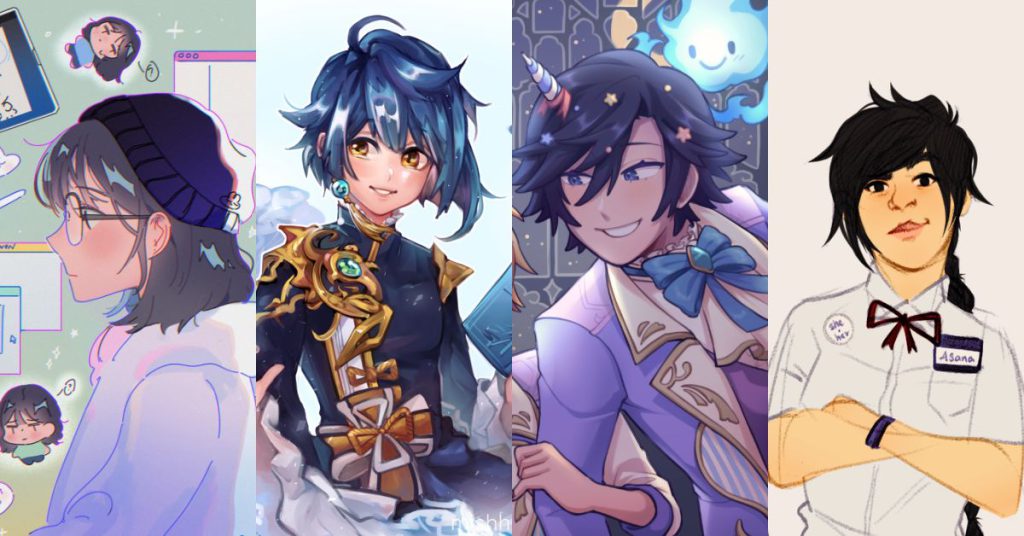The topic of NFTs has become rather polarising in recent years. There are those who see it as the future of art, while others seem dead set on the idea that NFTs are terrible.
Artists, particularly ones who have been immersed in digital culture, have somewhat been caught in the middle, unsure of whether to join in on the trend or risk missing out on what could be profits and the future.
So, I went on Twitter and reached out to some Malaysian digital artists who seem to have made up their minds about NFTs. Their verdict? They’re not good.
First (un)impressions of NFTs
Artist Shanice first heard about NFTs a year ago when they noticed some big artists minting their network. At the time, they didn’t understand much of it, just that people were hopping on the trend due to high-profit returns.
“Then, the more I read about it, the more I learnt about the plagiarising and environmental impacts it had,” they said.
Needless to say, Shanice is now anti-NFTs, and said they’ll never participate in it.
“Personally, I think it’s a big hoax that’s hard for people to comprehend, and harder for people to talk about,” M.KHT, a freelancing artist, opened up, “So far from what I can tell as a bystander, it just reeks of malintent.”
Due to the poor impression given by the NFT scene, most of the artists aren’t exactly doing further reading on the subject.
“Honestly I have not done a lot of reading on it and relied mostly on Twitter to get my information,” another artist, Ceniwen, admitted. “However, it is obvious to anyone not actively trying to look away that NFTs are terrible for the environment and use up too many materials for what is essentially a zero-sum game.”
Of course, social media is notorious for its ability to keep people in an echo chamber, as there is also a network of artists on Twitter who would say otherwise.
However, to M.KHT, the barriers to entry with understanding NFTs are part of the problem, as it means artists may end up being taken advantage of.
Environmental harm and art thievery
One of the biggest issues artists have with NFTs is the environmental impact blockchain technology has.
“I personally witnessed apartment units rented out just for people to mine bitcoin, snatching away actual real estate from people who need it more,” M.KHT shared.
However, as explained in our article on the climate controversy surrounding NFTs, there have been improvements made on that front to limit NFTs’ carbon footprint. One such progress is found in the proof-of-stake protocol instead of the typical energy-intensive proof-of-work protocol.

Yet, explaining as much doesn’t seem to change a lot of peoples’ minds. In fact, M.KHT thinks that defences made for the use of NFTs often explain things in a “convoluted” way. She also thinks that even if proof-of-stake results in greener NFTs, the energy can still be used to do other things.
Another Malaysian artist by the name of Tama agreed, saying that even if there is a more energy-efficient type of NFT, it’s still resulting in a net positive in terms of environmental damage.
“Even if NFTs were to generate no carbon footprint it is still a pyramid scheme at best which will only make the rich richer and the vulnerable to lose their money,” Ceniwen added.
On top of the supposed environmental harm, these artists have also noticed the issue of art theft.
“Anyone can upload anything and steal art from anyone to put up on NFT listing sites,” Tama, pointed out.
Shanice brought up the same issue of plagiarism, saying that NFTs only encourage the terrible behaviour of art theft, which is disrespectful to the original artists.
Another overarching problem M.KHT has noticed in the NFT industry lies in the uneducated investors. From her perspective, she thinks many investors who are looking to take a dip in the unregulated scene of NFTs have been treating artists poorly.
She said that many investors of NFTs are unfamiliar with the art industry, and would give out lucrative offers to desperate artists struggling to get by. These artists may end up being taken advantage of with underpayment and lack of ownership of their work.
Animosity within the community
Due to differing opinions on NFTs, there is now a level of tension in the art community, despite attempts to understand the other side of the story.
“I do know a lot of artists who would have quit art if it weren’t for NFTs because truth be told, it’s hard to make a living off art,” Ceniwen pointed out. “Obviously, there are a lot of bigger name artists who can live without NFTs but do so either because of greed or simple ignorance.”
They continued, “But that’s not the case for a lot of them when it’s the choice between making rent or the dubious morality of being involved in NFTs. I wish NFTs were the magical solution for struggling artists, but it’s not.”

M.KHT also agreed that art is a difficult career, so she doesn’t fault artists who have to work with NFTs or with companies that support NFTs.
“Even though I think it’s not the right thing to do, there are morally worse things a struggling artist can do in this time and day,” she said.
But M.KHT also recognised that the topic of NFTs has driven a wedge within the art community and caused a lot of tension between supporters and opposers of NFTs.
“I’m privileged enough to be able to pursue my own path as a freelancing artist,” M.KHT started. “Personally, from my perspective, there are no benefits in being an NFT artist over being a regular artist finding work in the real world.”
She continued to explain, “The NFT market is a system that you have to invest thousands of dollars just to get into, and if you’re not a well-established artist, you’re going to be met with a world of disappointment.”
M.KHT believes that if there is no clientele for your work, there is no point spending hundreds or even thousands to mint your work, and “bluff other gullible souls” to purchase your NFT to turn a small profit.
“Doesn’t that sound just like a pyramid scheme?” she wondered.
She further said that established NFT artists who claim to be earning millions with each transaction are not artists, but instead con artists. In her perspective, even if artists manage to earn millions, the hoops they have to go through to have that money are “borderline money laundering”.
Perhaps it’s because of all these factors that Shanice said, “It’s just totally unforgivable to me to see other artists continuing making/minting/supporting NFT artworks.”
The future of art
But despite all the arguments against NFTs, some artists such as M.KHT and Tama have to admit that it might be inevitable for NFTs to be the future of art.

“Like so many new technologies and ideas that have become the norm, I think an improved, regulated version of the current system will eventually become commonplace,” M.KHT explained.
Although, her overall outlook on the future of art is still rather bleak.
“When it comes to art, it always comes down to employability. Artists looking for work will have to bow to their investors or employers, and as long as there is a need for artists, they’ll unfortunately be taken advantage of.”
If such is the case, one wonders if the reason why can be pinned on Malaysia’s continued lack of appreciation for the arts, and whether artists will have better autonomy over what they want to do if the situation is turned around. We suppose only time will tell.
- Read more articles we’ve written on NFTs here.
Featured Image Credit: Ceniwen / M.KHT / Tama / Shanice











